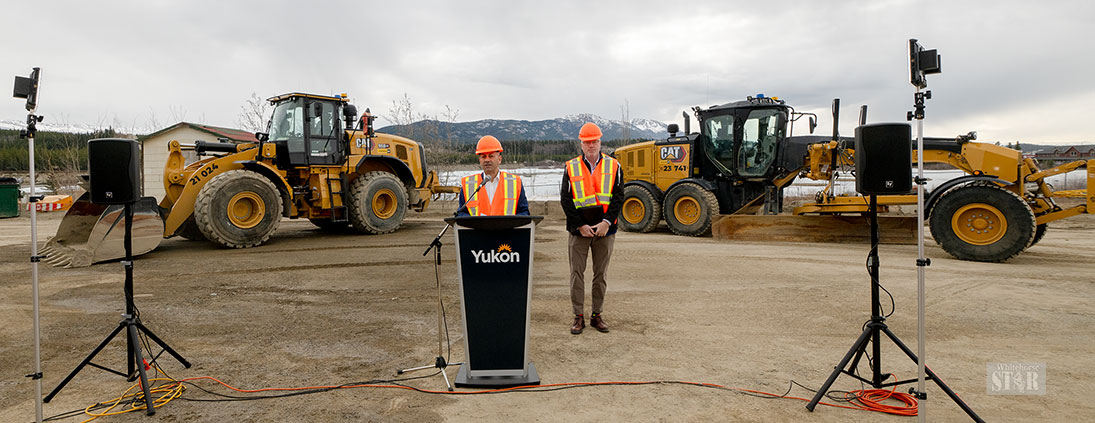North Alaska Highway in for major upgrades
The bumpy North Alaska Highway will become much safer and smoother over time.
By Dan Davidson on April 24, 2024
DAWSON CITY – The bumpy North Alaska Highway will become much safer and smoother over time.
Much-needed upgrades on the frost heave-plagued artery will begin in 2025 and continue until the end of 2027, it was announced Tuesday.
Construction and upgrades will be funded by a $31.125-million US (approximately $42.6-million Cdn) investment by the Alaska government through the Statewide Transportation Improvement Program (STIP).
“This funding will help to ensure safe and efficient travel for Yukoners and Alaskans along this critical northern route,” the Yukon government said in a statement.
“The Government of Yukon is pleased to see the impact of the territory’s closer relationship with the Government of Alaska resulting in benefits for Yukoners and Alaskans.”
The memorandum of under-standing for the work was signed Feb. 9 by Premier Ranj Pillai and Alaska Gov. Mike Dunleavy.
Details were provided at a press conference held Tuesday at the Whitehorse grader station.
As with the continuing work on the North Klondike Highway, there will be places where the North Alaska Highway road bed will be raised four or more metres to keep it from contacting the permafrost layers and avoiding spring and fall highway shifting.
Details of the management of the overall project were not available Tuesday.
The highway serves as the primary land link between southeast Alaska and the rest of the U.S. It connects many rural communities in the Yukon, including Haines Junction, Destruction Bay, Burwash Landing and Beaver Creek.
The roadway also links the traditional territories of the Champagne and Aishihik, Kluane and White River First Nations.
The MOU commits Alaska’s Department of Transportation and Public Facilities and the Yukon’s Department of Highways and Public Works to work together to restore sections of the highway in the Yukon.
The project will target a portion spanning approximately 222.5 kilometres from Destruction Bay to the Canada/U.S. border.
This section faces a range of road maintenance and safety challenges due to thawing permafrost.
Restoration efforts will involve resurfacing, repairing the road beneath the surface and culverts. It will also include improvement to the drainage to make sure the road can be used safely at vehicles’ intended speeds.
The project will also deal with improvements to the Haines Road between Haines Junction and Haines, Alaska.
The entire span from Haines to Beaver Creek is often referred to as the Shakwak Corridor.
“The Government of Yukon is pleased to work with Alaska on shared priorities that improve the prosperity, stability and well-being of both Alaskans and the Yukoners,” said Pillai.
“This partnership showcases the importance of working in collaboration towards a shared goal for northerners.
“The North Alaska Highway is a vital component of our collective regional infrastructure,” Pillai added.
“I know this funding commitment will ensure we can maintain the highway in optimal and safe condition for Yukoners, Alaskans and visitors.
“Maintaining this corridor bolsters security, facilitates trade, promotes tourism, and supports essential aspects of daily life in the North.”
In a statement, Dunleavy called the project “a significant milestone for Alaska as we advance our partnership with the Yukon.
“This success in the STIP application underscores the importance of maintaining a safe and efficient passage for all visitors to the North, and we look forward to an exciting construction season ahead.”
Highways and Public Works Minister Nils Clarke said he extends his “gratitude to Alaska for its contribution to restoring part of the North Alaska Highway with its Statewide Transportation Improvement Program.
“The funding allocated under this program will help mitigate the effects of thawing permafrost on this essential roadway. This contribution showcases both our governments’ recognition of the importance of this road link, as well as our commitment to keep the North Alaska
Highway safe for all road travellers.”
Clarke noted that highway maintenance was shared under the Shakwak Agreement from 1976 to 2015.
The depletion of that fund in 2015 left the Yukon with sole responsibility for keeping the road in useable condition.
Climate change has taken its toll on the road, especially on the stretch from Burwash Landing to the U.S. border, making it clear that more funding was needed in recent years. Negotiations on reconstruction began about a decade ago.
In February, the Yukon and Alaska submitted a joint application for U.S. government funding under the Rebuilding American Infrastructure with Sustainability and Equity (RAISE) discretionary grant program.
STIP is separate from RAISE funding, and work can proceed without the latter.
The Infrastructure Investment and Jobs Act (also called the Bipartisan Infrastructure Law) has specific language that allows portions of the Alaska Highway in Canada to compete for and receive U.S. federal grant funding for its reconstruction.
See related story below.

Comments (1)
Up 40 Down 7
Paul on Apr 24, 2024 at 6:39 pm
Meanwhile the Alaska Highway North of the Two Mile Hill within the City of Whitehorse is falling apart and is in the worst shape that any of us have ever seen it in our lifetimes...
(With apologies of course to the Yukoner's who are still here that remember the pre-1970's gravel road).